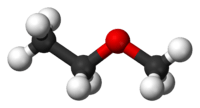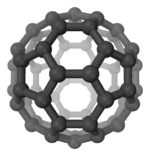Methoxyethane
 | |
 | |
| Names | |
|---|---|
| IUPAC name
Methoxyethane | |
| Other names
Methyl ethyl ether Ethyl methyl ether | |
| Identifiers | |
| 540-67-0 | |
| 3D model (Jmol) | Interactive image |
| ChEBI | CHEBI:39832 |
| ChemSpider | 10441 |
| ECHA InfoCard | 100.128.000 |
| PubChem | 10903 |
| |
| |
| Properties | |
| C3H8O | |
| Molar mass | 60.10 g·mol−1 |
| Appearance | Colorless gas[1] |
| Density | 0.7251 g cm−3 (at 0 °C)[1] |
| Melting point | −113 °C (−171 °F; 160 K) |
| Boiling point | 7.4 °C (45.3 °F; 280.5 K) |
| Refractive index (nD) |
1.3420 (at 4 °C)[1] |
| Viscosity | 0.224 cP at 25 °C |
| Hazards | |
| Main hazards | Extremely Flammable (F+), Liquefied gas |
| Safety data sheet | External MSDS |
| Related compounds | |
| Related Ethers |
Dimethyl ether Diethyl ether Methoxypropane |
| Except where otherwise noted, data are given for materials in their standard state (at 25 °C [77 °F], 100 kPa). | |
| | |
| Infobox references | |
Methoxyethane, also known as ethyl methyl ether, is an ethyl group with a bonded methoxy. Methoxyethane is a colorless gaseous ether with a medicine-like odor. It is extremely flammable, and its inhalation may cause asphyxiation or dizziness. As a Lewis base, it can react with Lewis acids to form salts and reacts violently with oxidizing agents.
References
- 1 2 3 Haynes, William M. (2010). Handbook of Chemistry and Physics (91 ed.). Boca Raton, Florida: CRC Press. p. 3-248. ISBN 978-1439820773.
This article is issued from Wikipedia - version of the 11/16/2015. The text is available under the Creative Commons Attribution/Share Alike but additional terms may apply for the media files.
